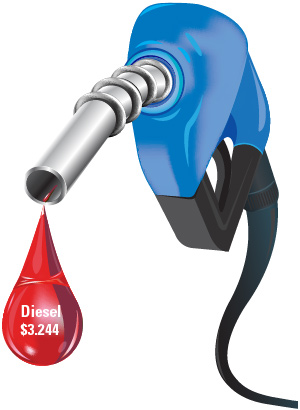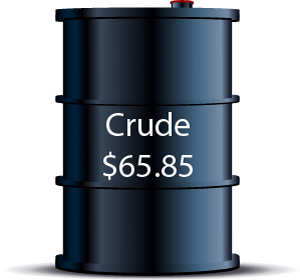Diesel Price Drops Again to $3.244 a Gallon

The U.S. average retail price of diesel fuel fell 2.2 cents to $3.244 a gallon, the third week in a row of moderate declines, according to the weekly report from the U.S. Department of Energy’s Energy Information Administration. On June 4, a gallon of diesel averaged $3.285 a gallon nationally.
Diesel remains more expensive than a year ago, up 75.5 cents per gallon compared with the same period in 2017.

The average price of diesel also fell in all regions nationwide. It dropped 1.4 cents a gallon to $3.976 in California, but that state remains the most expensive place in the country to buy the fuel. Diesel in California has gone up $1.092 in the past year.
The West Coast without California saw the cost of a gallon of diesel at $3.473, down 1.6 cents from the previous week but up 81.8 cents for the year. The Gulf Coast had the lowest price nationally at $3.016 a gallon, down 2.1 cents a gallon for the week but up 68.7 cents in the past year, EIA reported.
Rising fuel costs can be extremely disruptive, said Joe Carlier, senior vice president of sales with Penske Logistics. Penske aggressively installs new technology in its trucks, and they typically achieve good miles per gallon so the impact can be less immediate.
“Any increase is difficult to absorb,” Carlier said. “When we discuss rates with our customers, we consider the driver shortage. When you throw fuel into the mix, it adds further complexity to the discussion.”

Fuel costs always have generated efforts to improve diesel mpg for Class 8 trucks. A current approach is the Project Starship concept truck from Shell Rotella and Airflow Truck Co. that recently drove more than 2,300 miles from San Diego to Jacksonville, Fla., with a 40,000-pound load.
The Starship is a street-legal tractor-trailer built over three years equipped with a variety of technologies designed to improve fuel efficiency. It includes a cab that is 100% carbon fiber, an aerodynamic tail and a 5,000-watt solar panel on the trailer roof that powers blower motors, gauges and air conditioning.
The final truck and cargo weight was nearly 73,000 pounds, Shell reported.
The North American Council for Freight Efficiency tracked and verified the efficiency of the Starship truck on its cross country trip and found it averaged 8.94 mpg, nearly 40% better than the 6.4 mpg average typically seen by over-the-road Class 8 trucks.
The Starship attained 178.4 ton-miles per gallon freight ton efficiency — nearly 248% higher than the North American average of 72 ton-miles per gallon, NACFE Executive Director Mike Roeth noted.
Shell deserves credit for taking the truck on a long route with a heavy load and for conducting the test in an uncontrolled environment with several technologies that hadn’t been tested in the real world, according to Roeth.

A view of Shell's new Starship truck at 2018 MATS by John Sommers II for Transport Topics.
Shell announced it planned to apply what it learned and add additional technology to the Starship for further testing.
Fuel futures also have been static. The price of near-term West Texas Intermediate crude oil futures settled June 18 at $65.85 a barrel on the Nymex, up 79 cents for the day. One week ago, crude oil futures settled at $66.10 a barrel.
The U.S. average price of a gallon of regular gasoline at the pump dropped 3.2 cents to $2.879 — a rise of 56.1 cents from a year ago, EIA reported. Gasoline prices also fell in all regions of the country.
The most expensive gasoline was on the West Coast, including California. The price was $3.434 a gallon, down 1.8 cents a gallon from last week but up 57.4 cents in the past year. The cheapest gas is on the Gulf Coast, selling for $2.654 a gallon, down 4.2 cents from the previous week.
Indications are prices could continue to fall. Energy analysts reported that Russia and Saudi Arabia planned to call for an increase in oil production at the meeting of the Organization of Petroleum Exporting Countries in Vienna on June 22-23. An OPEC-led production cut that began in 2017 is one reason prices have gone up this year.




